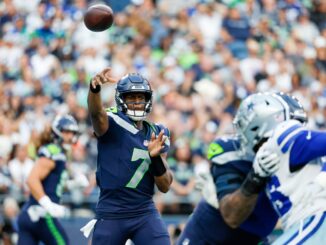
Have you ever been on the sidelines of an NFL or major college football field while the action is underway? I have. For those of you that haven’t, know this: The speed and ferocity of the collisions of the enormously skilled and enormously sized men is far, far more violent than you can perceive via your hi-def, 65″ TV screen, from your bar stool or from your bleacher seat.
My point? The sport of American football is ultra violent. We know that. Football players and fans accept that. Football players and fans seek that. It is fundamental to the enduring popularity of the sport.
Is football purely violent? No. Much of the sport’s appeal is due to the poetic nature of football in addition to its inherent violence. Yeah, I said poetic. The sublime, unexpected, unspoken connections between quarterback/receiver give rise to sudden realizations of greatness amid such ferocity that other sports cannot match. There are beauties both subtle and grand: The pick-up of the unseen rushing defensive lineman on a stunt; the lineman that directs the monster rusher just enough out of the quarterback’s way to make the sublime connection possible; the make-you-miss evasiveness of the running back one play after he ran over a linebacker; the remembrance and payback from earlier punishments. …
OK, so the violence is part of the poetry. It is fundamental to the sport’s appeal. And it is exactly the violence — or certain aspects of it — that will one day kill the sport.
Because human brains have not gotten bigger, faster and stronger — like the rest of the human body parts in the NFL.
111 NFL brains studied; 110 had CTE
There is no more chilling statistic. The July 25, 2017 Journal of the American Medical Association original investigation’s 99 percent rate of incidence — sliced, diced and dissected in the media — [Clinicopathological Evaluation of Chronic Traumatic Encephalopathy in Players of American Football (Jesse Mez, MD; Daniel H. Daneshvar, MD; Patrick T. Kiernan; et al)] is the final nail in the NFL’s, the NCAA’s, high school’s and lower levels of football’s coffins.
It’s only a matter of when.
If you’ve read this far, you probably don’t want to believe it. Football is deeply woven into the American fabric.
Is it the case that these 110 men all suffered crushing, debilitating hits to the head? Who knows. There is no way to add up all of the collisions they endured at every level of practicing and playing the sport of football.
Not only the haymakers
A study published online in Brain, a journal of neurology, “High impact research: investigating the effects of repetitive head injury,” presents the strongest case yet that repetitive hits to the head that don’t lead to concussions — meaning no loss of consciousness or other symptoms that can include headaches, dizziness, vision problems or confusion — cause CTE.
From NPR:
“We’ve had an inkling that subconcussive hits — the ones that don’t [show]neurological signs and symptoms — may be associated with CTE,” says Dr. Lee Goldstein, an associate professor of psychiatry at the Boston University School of Medicine and the lead investigator on the study. “We now have solid scientific evidence to say that is so.”
What we do know now is that it doesn’t take a “big” hit to cause CTE. In fact, we now know that a number of moderate or lesser hits during the course of one’s lifetime can just as likely be responsible for causing CTE.
It’s not just NFLers. Study: CTE diagnosed in 99% of former NFL players, 87% of ex-players at all levels
Will every football player get CTE? Probably not. That’s the good news. The JAMA study, and others, relies on the donated brains of deceased football players, by their families who suspected they may have CTE. As noted aging researcher, Dr. Eric B. Larson, of the Kaiser Permanente Washington Health Research Institute wrote in a recent blog post on Medium, “Working with this selected sample means that the researchers could be more likely to find evidence of harms than if they studied a random selection of athletes’ brains.”
It’s not possible to assert that all football players will end up with CTE. But the incidence rate is high. Disturbingly high. It is the single-greatest threat to the sport’s ongoing existence. There is no known cure. There is no known way to prevent CTE.
Except to not engage in activities that involve multiple head collisions. Like football.
If you made it to the NFL, it’s almost certainly already too late for you
What do you do if the sport you built your life around proves to be too damaging to continue supporting? Here is one man’s answer:
The decision for Cunningham could not have been easy. He built his life around football: Captain of a National Championship team in college. Five years in the NFL. Twenty years as an NFL & college football broadcaster.
But what do you do if you’re Mr. Super Bowl, the G.O.A.T., Tom Brady of the New England Patriots? To date, he’s not taking the route that Cunningham took. In fact, Brady, still very much invested in adding to his football legacy, plays coy about if and the extend of any head injuries he has suffered. And they’re doing damage not only to him, but the viability of the sport. But he’s not alone — Brady’s obfuscation is part and parcel of the NFL’s tough guy culture.
If Brady says this about concussions:
“… the Patriots quarterback reminded us that any potential concussion he may have had last season was not ‘anybody’s business.’” (Aug. 4, 2017)
How can other mere mortal football players be expected to be forthcoming or in any way transparent about their head injuries?
From a whisper to a murmur
CTE becoming the doom of the uber-lucrative NFL is no longer a fanciful conspiracy theory:
As more and more former players exhibit and/or come out admitting they suspect they may have CTE, the murmur will one day grow to a steady shout. Former Super Bowler Boomer Esiason is one of a growing number:
And the sport’s victims are being tallied. See this very grim list by Sports Illustrated: “NFL players diagnosed or showing symptoms of CTE or ALS.”
Naturally, with all aging/brain disorders, it is not only the individual who’s life is destroyed. Loved ones bear the brunt of the sport’s destruction of the brain:
Football is deeply woven into the American fabric. But fabrics don’t last forever. What happens to a sport when its previously fertile breeding grounds — high school football — begin to close down?
It is the first of several dominoes. The sport — the monumentally successful National Football League — is in peril. If you can solve the threat of CTE, you are likely to become rich beyond your wildest dreams.
So yeah, if you love football, this is a bummer. This reality check can no longer be ignored. One day, we will have seen our last high school football game, our last college football extravaganza, our last professional contest and our last Super Bowl. For some, last Sunday’s contest may be the last Super Bowl they can watch.
Will it be yours?



